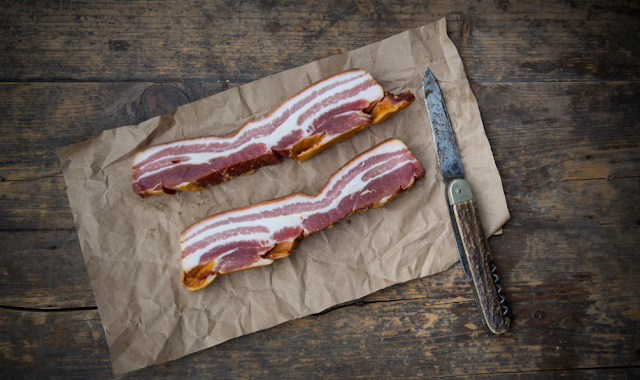Bacon is a cured meat, made by letting a slab of pork belly (or side or loin or fatback) sit in brine or salt for a while to preserve it. So if all bacon is cured by definition, what is uncured bacon? And, perhaps more importantly for the average bacon enthusiasts’ needs, is there a difference between the two? In a world with so many different types of bacon, it can be hard to know if the difference between cured and uncured bacon is real or some kind of marketing ploy, especially since it can be challenging to tell which type you’re eating if you’re just handed a slice.
Your taste buds aren’t deceiving you because the difference between cured and uncured bacon pretty negligible. You could even argue that uncured bacon doesn’t really exist. As Melanie Abel, director of marketing at Smithfield Foods, the leading U.S. producer of packaged pork products, explained, “Since all bacon is preserved with either smoke or salt, there really is no such thing as uncured bacon. It’s kind of like a myth.”
The difference between the two types of bacon, then, comes down to the way in which the pork is preserved. Cured bacon is made by adding artificial nitrates, usually sodium nitrite, into the regular salt and brine mixture. That added sodium nitrite is an important ingredient in the curing process because it helps prevent the growth of bacteria on the meat itself, but nitrates and nitrites have gotten a bad rap ever since the World Health Organization announced that processed meats might cause colorectal cancer in October 2015.
Those health concerns about carcinogens in bacon are part of the reason uncured bacon has seen a jump in popularity—because uncured bacon is made without added or artificial nitrates and nitrites. But contrary to popular belief, uncured bacon is not nitrate-free because, as Abel explained, “You’re using sea salt or celery powder to achieve those naturally-occurring nitrates.” After about a week of curing, those nitrates will show up in your bacon whether you’ve added them artificially or not, least of all because celery salt is a naturally occurring nitrate.
So if it’s not about the nitrates, then the difference between cured and uncured bacon really comes down to taste and preference. Uncured bacon is, generally, left in a more natural, green state than cured bacon and so tastes more like the pork belly itself. It’s also often saltier than cured bacon because the pork has to sit in the brine for longer in order to get to the same level of preservation.
But even that can be a subtle difference since curing is only one of many steps that must be taken before you can have a slice on your griddle. “It’s a combination of the curing and smoking that will give you the different, rich flavor,” said Abel. “Smithfield bacon, for example, is all-natural smoked with hickory chips, and that’s what’s really going to bring that taste to life,” not the curing process. Even famed Benton’s Hickory Smoked Country Bacon gets most of its oomph from the smoking process rather than the cure.
Long story short, if you’re looking for that full, bacon taste, you’ll probably want to opt for cured bacon rather than uncured, especially since there’s no noticeable difference in health or nutritional value between the two. But you really can’t go wrong either way.



0 Comments